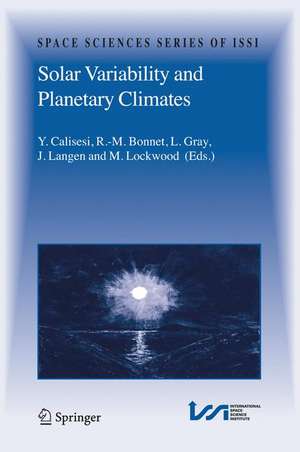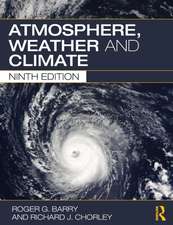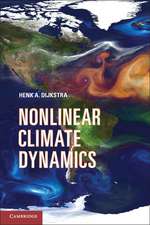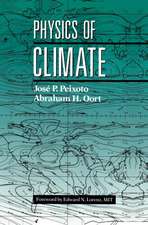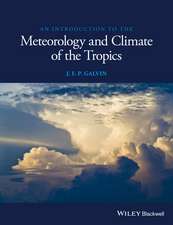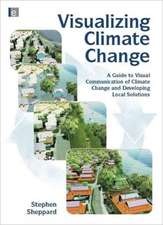Solar Variability and Planetary Climates: Space Sciences Series of ISSI, cartea 23
Editat de Y. Calisesi, R.-M. Bonnet, L. Gray, J. Langen, M. Lockwooden Limba Engleză Hardback – 6 apr 2007
| Toate formatele și edițiile | Preț | Express |
|---|---|---|
| Paperback (1) | 953.52 lei 6-8 săpt. | |
| Springer – 19 noi 2010 | 953.52 lei 6-8 săpt. | |
| Hardback (1) | 964.10 lei 6-8 săpt. | |
| Springer – 6 apr 2007 | 964.10 lei 6-8 săpt. |
Din seria Space Sciences Series of ISSI
- 15%
 Preț: 654.30 lei
Preț: 654.30 lei - 18%
 Preț: 1019.49 lei
Preț: 1019.49 lei - 15%
 Preț: 647.27 lei
Preț: 647.27 lei - 18%
 Preț: 959.50 lei
Preț: 959.50 lei - 18%
 Preț: 1406.98 lei
Preț: 1406.98 lei - 18%
 Preț: 904.91 lei
Preț: 904.91 lei - 18%
 Preț: 1123.35 lei
Preț: 1123.35 lei - 18%
 Preț: 908.36 lei
Preț: 908.36 lei - 18%
 Preț: 903.93 lei
Preț: 903.93 lei - 20%
 Preț: 577.35 lei
Preț: 577.35 lei - 18%
 Preț: 1115.46 lei
Preț: 1115.46 lei - 18%
 Preț: 1009.70 lei
Preț: 1009.70 lei - 18%
 Preț: 796.61 lei
Preț: 796.61 lei - 18%
 Preț: 739.81 lei
Preț: 739.81 lei - 18%
 Preț: 899.21 lei
Preț: 899.21 lei - 18%
 Preț: 1126.52 lei
Preț: 1126.52 lei - 18%
 Preț: 1016.01 lei
Preț: 1016.01 lei - 18%
 Preț: 1398.80 lei
Preț: 1398.80 lei - 15%
 Preț: 545.15 lei
Preț: 545.15 lei -
 Preț: 436.35 lei
Preț: 436.35 lei -
 Preț: 430.59 lei
Preț: 430.59 lei - 18%
 Preț: 983.65 lei
Preț: 983.65 lei -
 Preț: 412.78 lei
Preț: 412.78 lei - 18%
 Preț: 956.50 lei
Preț: 956.50 lei - 18%
 Preț: 950.52 lei
Preț: 950.52 lei - 18%
 Preț: 951.29 lei
Preț: 951.29 lei - 24%
 Preț: 1060.12 lei
Preț: 1060.12 lei - 18%
 Preț: 958.88 lei
Preț: 958.88 lei - 24%
 Preț: 788.97 lei
Preț: 788.97 lei - 15%
 Preț: 707.00 lei
Preț: 707.00 lei - 18%
 Preț: 951.59 lei
Preț: 951.59 lei - 24%
 Preț: 1052.17 lei
Preț: 1052.17 lei - 20%
 Preț: 574.08 lei
Preț: 574.08 lei - 18%
 Preț: 964.10 lei
Preț: 964.10 lei - 15%
 Preț: 647.40 lei
Preț: 647.40 lei - 18%
 Preț: 961.55 lei
Preț: 961.55 lei - 18%
 Preț: 964.23 lei
Preț: 964.23 lei
Preț: 964.10 lei
Preț vechi: 1175.73 lei
-18% Nou
Puncte Express: 1446
Preț estimativ în valută:
184.54€ • 200.52$ • 155.11£
184.54€ • 200.52$ • 155.11£
Carte tipărită la comandă
Livrare economică 21 aprilie-05 mai
Preluare comenzi: 021 569.72.76
Specificații
ISBN-13: 9780387483399
ISBN-10: 038748339X
Pagini: 474
Ilustrații: XII, 474 p. 204 illus., 93 illus. in color.
Dimensiuni: 155 x 235 x 23 mm
Greutate: 0.98 kg
Ediția:2007
Editura: Springer
Colecția Springer
Seria Space Sciences Series of ISSI
Locul publicării:New York, NY, United States
ISBN-10: 038748339X
Pagini: 474
Ilustrații: XII, 474 p. 204 illus., 93 illus. in color.
Dimensiuni: 155 x 235 x 23 mm
Greutate: 0.98 kg
Ediția:2007
Editura: Springer
Colecția Springer
Seria Space Sciences Series of ISSI
Locul publicării:New York, NY, United States
Public țintă
ResearchCuprins
Solar Output Variability.- Assessing Solar Variability.- Solar Variability of Possible Relevance for Planetary Climates.- Measurement of Total and Spectral Solar Irradiance.- Solar Irradiance Variability Since 1978.- Solar Variability Over the Past Several Millennia.- Solar and Heliospheric Modulation of Galactic Cosmic Rays.- What Do Cosmogenic Isotopes Tell Us about Past Solar Forcing of Climate?.- Tropospheric Aerosols, Radiation Budget, and Changes.- Observed Long-Term Variations of Solar Irradiance at the Earth’s Surface.- Aerosol Effects on Clouds and Climate.- Satellite Observations of Natural and Anthropogenic Aerosol Effects on Clouds and Climate.- Aerosol-Cloud Interactions Control of Earth Radiation and Latent Heat Release Budgets.- Atmospheric Ion-Induced Aerosol Nucleation.- Atmospheric Aerosol and Cloud Condensation Nuclei Formation: A Possible Influence of Cosmic Rays?.- Climate Change: Detection and Attribution.- On the Response of the Climate System to Solar Forcing.- Detection and Attribution of Climate Change, and Understanding Solar Influence on Climate.- The Climate Response to the Astronomical Forcing.- Regional Response of the Climate System to Solar Forcing: The Role of the Ocean.- Middle Atmospheric Response to Solar Variability.- Discussion of the Solar UV/Planetary Wave Mechanism.- Solar Variation and Stratospheric Response.- Signature of the 11-Year Cycle in the Upper Atmosphere.- The Middle Atmospheric Ozone Response to the 11-Year Solar Cycle.- Influence of the Solar Cycle on the General Circulation of the Stratosphere and Upper Troposphere.- Multidecadal Signal of Solar Variability in the Upper Troposphere During The 20th Century.- The Role of Dynamics in Solar Forcing.- Solar Influences on Dynamical Coupling Between the Stratosphere andTroposphere.- The Response of the Middle Atmosphere to Solar Cycle Forcing in the Hamburg Model of the Neutral and Ionized Atmosphere.- A Possible Transfer Mechanism for the 11-Year Solar Cycle to the Lower Stratosphere.- Recent Space Data.- Recent Space Data.- Satellite Measurements of Middle Atmospheric Impacts by Solar Proton Events in Solar Cycle 23.- Impact of Solar Activity on Stratospheric Ozone and No2 Observed by GOMOS/ENVISAT.- The Stratospheric and Mesospheric NOy in the 2002–2004 Polar Winters as Measured by MIPAS/ENVISAT.- Early Data from Aura and Continuity from UARS and Toms.- Planetary Science.- What Do We Know about the Climate of Terrestrial Planets?.- Solar Variability and Climate Impact on Terrestrial Planets.- Climate Variability on Venus and Titan.- The Orbital Forcing of Climate Changes on Mars.
Textul de pe ultima copertă
Variations in solar activity, as revealed by variations in the number of sunspots, have been observed since ancient times. To what extent changes in the solar output may affect planetary climates, though, remains today more than ever a subject of controversy. In 2000, the SSSI volume on Solar Variability and Climate reviewed the to-date understanding of the physics of solar variability and of the associated climate response. The present volume on Solar Variability and Planetary Climates provides an overview of recent advances in this field, with particular focus at the Earth's middle and lower atmosphere. The book structure mirrors that of the ISSI workshop held in Bern in June 2005, the collection of invited workshop contributions and of complementary introductory papers synthesizing the current understanding in key research areas such as middle atmospheric processes, stratosphere-troposphere dynamical coupling, tropospheric aerosols chemistry, solar storm influences, solar variability physics, and terrestrial climate analogues.
Caracteristici
Understanding the causes and effects of climate change is probably one of the most crucial scientific challenges of our time. This book provides an updated overview of the processes determining the influence of solar forcing on climate. It discusses in particular the most recent developments regarding the role of aerosols in the climate system, and the new insights that could be gained from the investigation of terrestrial climate analogues. Scientists from different disciplines such as solar, atmospheric, and climate physics and chemistry have gathered to provide a state-of-the art collection of most recent findings and views as to solar-terrestrial relationships. These do provide a worthy inspiration source and a solid scientific basis for future developments and research. For the first time, the role played by natural and anthropogenic aerosols in the Earth climate system is reviewed in the context of solar-terrestrial relationships, and their potential role in offsetting global warming is discussed. Includes supplementary material: sn.pub/extras
